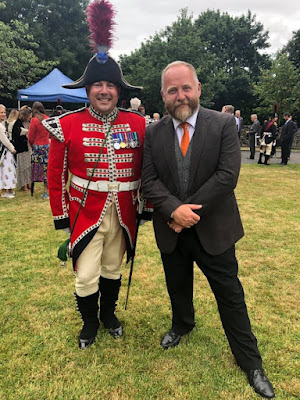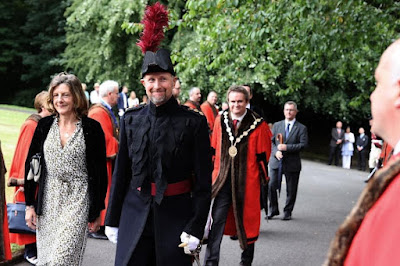 |
| Prospect of Rathlin's Harbour from the Manor House (Image: Timothy Ferres, 2021) |
I last stayed on Rathlin Island
four years ago, in August, 2017; its allure is quite irresistible to me.
The island's population has doubled in my lifetime, and now totals about 170.
Not so long ago the little primary school had eight pupils; whereas today that figure has increased to almost twenty.
My journey began at Ballycastle, County Antrim, where I embarked upon the ten o'clock vehicle ferry for the 45-minute sailing to Church Bay, Rathlin's nucleus.
I should explain that there are two ferries: a fast one, which takes merely 15 or 20 minutes; and a slower one, which can take vehicles.
I stayed at the manor house guest-house, ancestral home of the
GAGES, landlords and proprietors of Rathlin Island since the mid-18th century.
I think they purchased the island from the Earl of Antrim for the princely sum of £1,750, the equivalent of about £400,000 today. Quite a bargain!
During my stay on the island I encountered quite a few interesting people.
Since I've already wrote a bit about the
MANOR HOUSE GUEST-HOUSE in 2017, I propose to recount one or two of my walks.
On Tuesday, August 17th, I walked eleven and a half miles, from the manor house in a westerly direction to the Kinramer North and Kebble South trails.
I began my walks from the manor house, which is directly opposite the main harbour.
The weather was inclement during most of my stay, so I wore my 1990s pair of Raichle hiking boots, with waterproof over-trousers and anorak; and a little backpack with binoculars, something to drink, directions, etc.
By the way, the old hiking boots gave me trouble: one of my ankles was sore, and the boots were leaking (subsequently I purchased a new pair of Salomon Quest Four hiking-boots).
On Wednesday, August 18th, I decided to ramble from my accommodation at the manor house towards the East Lighthouse and Ballyconaghan.
 |
Former Pigeon-House beside the Manor House
(Image: Timothy Ferres, 2021) |
As I passed the former coach-yard, attached to the manor house, I peered in and under the arch, to the left, the former pigeon-house could be seen.
What is now the island's health centre, at the other side of the arch, was once a livestock barn.
Just past the health centre there's a former coal-yard, which also has an arch and matching doors; and a distinctive carved stone erected by the Rev Robert Gage in 1816.
I walked further along Church Bay and turned left at McCuaig's Bar, up a short, steep road to a junction, where I turned right.
This used to be a busy thoroughfare on the island, with a grocer's shop, the rectory, the police station, a public house, and the smithy.
The former police station, I suspect, is on private land, so I didn't venture towards it; though I believe that it was originally called Ballynoe House, and was the residence of the MacDonnells, Earls of Antrim, who sold Rathlin to the Gages.
 |
| The Glebe House, Rathlin Island (Image: Timothy Ferres, 2021) |
The Glebe House, as it's now known, was once the rectory.
The last rector to reside there, I think, was the Rev George James Boucher, Rector of St Thomas's from 1950-56.
The Gages have been using it as their island residence since about 1975.
 |
| The former Smithy, Rathlin Island (Image: Timothy Ferres, 2021) |
A bit further along the road I passed the smithy or forge, where the resident blacksmith made and repaired cartwheels, nails, and shod horses.
After ten or fifteen minutes I came to a clachan or cluster of three houses up a short lane.
These dwellings belonged to the McQuilkins and the Cecils.
 |
| The McQuilkin and Cecil Clachan (Image: Timothy Ferres, 2021) |
They're all derelict and quite dilapidated, though not beyond restoration; the first house on the left probably being the most recent building.
HAVING had a brief look through the closed gates of the East Lighthouse, I turned back along the track, and made my way to the National Trust trail.
Eventually I reached another clachan of four cottages at Crocknanagh, where more McQuilkins and Currys lived.
 |
| The Crocknanagh Clachan (Image: Timothy Ferres, 2021) |
I'm told that the McQuilkins had a pretty little walled garden under the tree, where colourful shrubs thrived.
I've already written about the coastguard hut at the top of Cantruan hill and, on this occasion, I decided to omit it from my walk; so I walked back to the tarmac road, down a gently sloping incline, and walked past the Catholic church of the Immaculate Conception, built in 1864 to replace an older church.
Part of the interior wall of the previous church remains behind the present one; and a series of steps lead up to the relatively modern 1980s parochial house.
No parish priests have lived here permanently since 1999.
 |
| The former Pound, Rathlin Island (Image: Timothy Ferres, 2021) |
Directly opposite the church is the children's playground, originally a small field where stray animals were impounded by the landlords, the Gages.
Anybody who owned one of these stray animals was compelled to pay a fee for its release; a considerable deterrent I imagine!
 |
| The Parochial Hall, Rathlin Island (Image: Timothy Ferres, 2021) |
Beside the playground is the parochial hall, built about a century ago; and further along is the primary school, which had a mere eight pupils five or six years ago.
Today numbers are increasing, and I'm told that there are up to twenty children.
When they reach the age of eleven, they need to attend classes on the mainland.
 |
| Former Shop opposite the School (Image: Timothy Ferres, 2021) |
On the other side of the road is a tiny one-storey building with two large windows and a door.
It was closed when I saw it, though I peered inside and it seems to be an artist's studio of some sort.
It was originally a little general merchant's shop.
Islanders were generally self-sufficient in fruit and vegetables, eggs, and dairy produce.
Certainly there's a lot to explore on Rathlin.
The Cooraghy Bay pier could be developed as an industrial tourist attraction, for instance.
This pier was constructed in order to convey building materials for the new West Lighthouse about 1910.
 |
| Abandoned Pier at Cooraghy Bay (Image: Timothy Ferres, 2021) |
From the top of the cliff, a series of steep concrete steps, with a single hand-rail, lead down towards the pier, though they terminate suddenly not far down the cliff, making it hazardous to attempt the descent today.
An ingenious method of hauling the building materials up was conceived with, quite literally, horse-power, winches, a derrick, and rail lines.
I purchased a very good guide called Eight Walks On Rathlin Island, written by Nicky Sebastian in 2018.
I bought it in the manor house, and heartily recommend it.



























